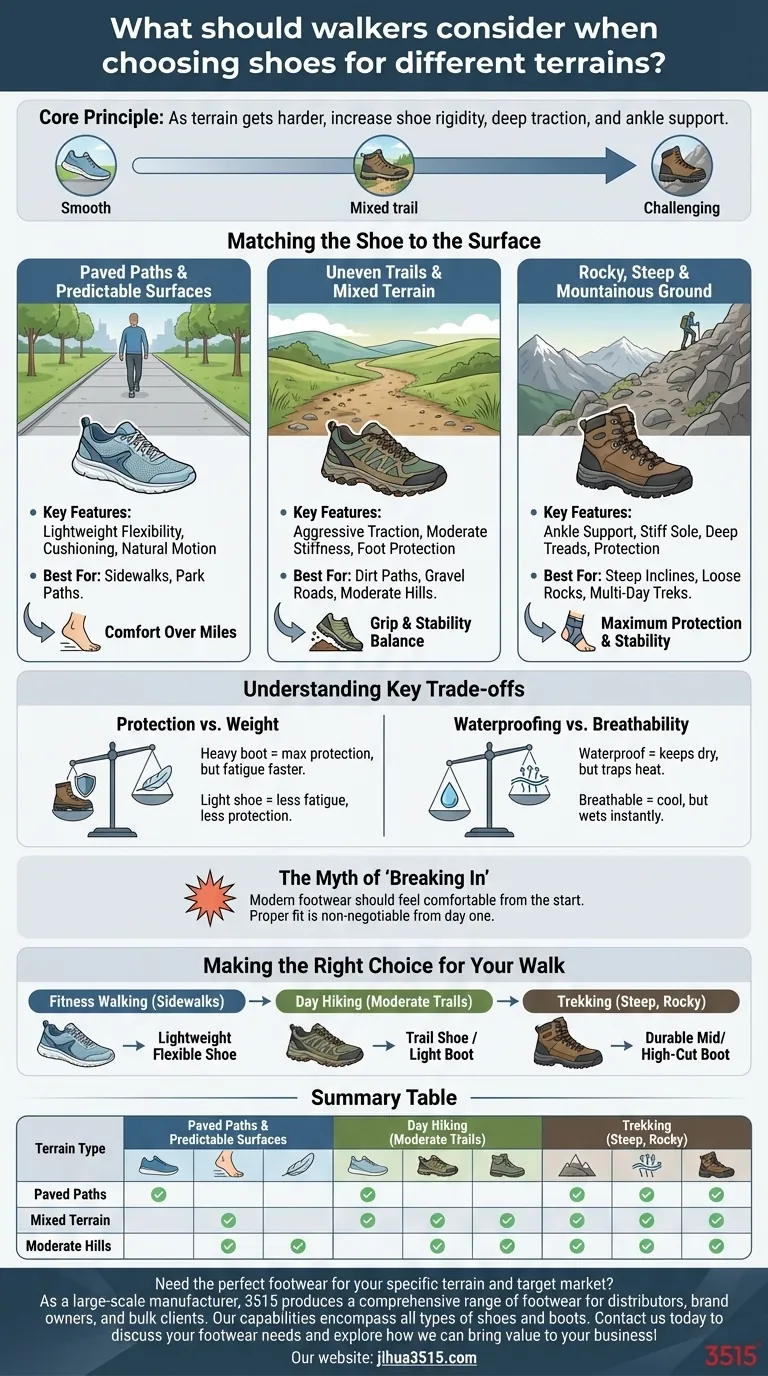To choose the right walking shoe for different terrains, you must match the shoe's key features—traction, support, and flexibility—directly to the demands of the surface. For smooth, predictable paths, prioritize lightweight flexibility, while for rugged, uneven trails, you need to shift your focus to robust traction and rigid support to ensure safety and comfort.
The core principle is simple: as the terrain becomes more unpredictable and challenging, the need for shoe rigidity, deep traction, and ankle support increases. Conversely, for stable and even surfaces, flexibility and light weight are your primary allies.

Matching the Shoe to the Surface
The ground beneath your feet dictates the engineering you need in your footwear. A shoe designed for pavement will fail on a mountain trail, and a heavy-duty hiking boot will feel cumbersome and tiring on a flat park path.
For Paved Paths and Predictable Surfaces
On surfaces like concrete, asphalt, or well-maintained park paths, the ground is consistent. Your primary needs are cushioning to absorb impact and flexibility to allow a natural walking motion.
Look for a lightweight walking shoe. The sole should be flexible, and deep, aggressive treads are unnecessary. The focus here is on comfort over many miles of repetitive, predictable steps.
For Uneven Trails and Mixed Terrain
This category includes dirt paths, gravel roads, and rolling hills where the surface can be loose or irregular. Your needs shift from pure flexibility to a balance of grip and stability.
A dedicated trail shoe or a lightweight walking boot is ideal. These offer more aggressive outsoles (treads or lugs) for better grip on dirt and rock, and a slightly stiffer sole to protect your feet from sharp objects underfoot.
For Rocky, Steep, and Mountainous Ground
When tackling challenging terrain with steep inclines, loose rocks, or mud, your top priorities become protection and stability.
Here, a mid or high-cut boot is essential. The higher cuff provides crucial ankle support to prevent twists. The sole should be very stiff to provide a stable platform on uneven ground, and the treads must be deep and widely spaced for maximum grip.
Understanding the Key Trade-offs
Choosing the perfect shoe always involves balancing competing features. Understanding these trade-offs is key to making an informed decision that aligns with your specific needs.
Protection vs. Weight
A heavy-duty, durable boot offers maximum protection from rocks and impacts and provides superior support. However, this comes at the cost of weight, which can lead to fatigue more quickly.
A lightweight shoe reduces fatigue and allows for faster movement but offers less protection and is generally less durable.
Waterproofing vs. Breathability
Waterproof membranes are excellent for keeping your feet dry in wet, muddy, or snowy conditions. The downside is that they trap heat and sweat, which can be very uncomfortable in hot, dry climates.
Highly breathable, non-waterproof shoes are perfect for warm weather, allowing moisture to escape and keeping your feet cool. They will, however, become saturated instantly in wet conditions.
The Myth of "Breaking In"
Unlike old leather shoes, modern technical footwear, especially boots with synthetic materials, should feel comfortable from the start.
While a shoe might adapt slightly to your foot over time, a shoe that is tight, pinches, or causes discomfort in the store will not magically become comfortable later. Proper fit is non-negotiable from day one.
Making the Right Choice for Your Walk
Ultimately, the best shoe is the one that fits both your foot and your intended environment. Use these guidelines to narrow your search.
- If your primary focus is fitness walking on sidewalks and park paths: Prioritize a lightweight, flexible, and well-cushioned walking shoe.
- If your primary focus is day hiking on moderate, uneven trails: Select a trail shoe or light hiking boot that offers a balance of good traction, moderate stiffness, and some ankle support.
- If your primary focus is tackling steep, rocky, or multi-day treks: Invest in a durable, mid-to-high-cut hiking boot with a stiff sole and excellent ankle support.
By matching your shoe's design to the terrain, you empower yourself to walk farther, safer, and more comfortably.
Summary Table:
| Terrain Type | Recommended Footwear | Key Features to Prioritize |
|---|---|---|
| Paved Paths & Predictable Surfaces | Lightweight Walking Shoe | Flexibility, Cushioning, Light Weight |
| Uneven Trails & Mixed Terrain | Trail Shoe / Light Hiking Boot | Aggressive Traction, Moderate Stiffness |
| Rocky, Steep & Mountainous Ground | Mid/High-Cut Hiking Boot | Ankle Support, Stiff Sole, Deep Treads |
Need the perfect footwear for your specific terrain and target market?
As a large-scale manufacturer, 3515 produces a comprehensive range of footwear for distributors, brand owners, and bulk clients. Our production capabilities encompass all types of shoes and boots—from lightweight walking shoes for urban paths to durable hiking boots for challenging trails. We can help you source or develop the ideal products to meet your customers' demands for safety, comfort, and performance.
Contact us today to discuss your footwear needs and explore how we can bring value to your business!
Visual Guide

Related Products
- Durable Rubber-Soled Utility Shoes for Wholesale & Custom Brand Manufacturing
- Premium KPU Athletic Safety Shoes for Wholesale
- Wholesale Durable Camouflage Canvas Shoes with High-Traction Cleated Rubber Sole
- Wholesale Breathable Training Shoes Custom Athletic Footwear Manufacturer
- Custom Safety Shoe Manufacturer for Wholesale & OEM Brands
People Also Ask
- What are rubber soled shoes? The Ultimate Guide to Durable, All-Weather Footwear
- What makes rubber sole shoes an economical and practical choice? Unmatched Durability & All-Weather Value
- What historical breakthrough in 1844 contributed to modern shoe sole manufacturing? The Vulcanization Revolution
- What are the main applications of vulcanized rubber? Unlock Durability for Tires, Footwear & More
- What is vulcanized rubber and why is it used in products? The Key to Durable, Flexible Footwear



















